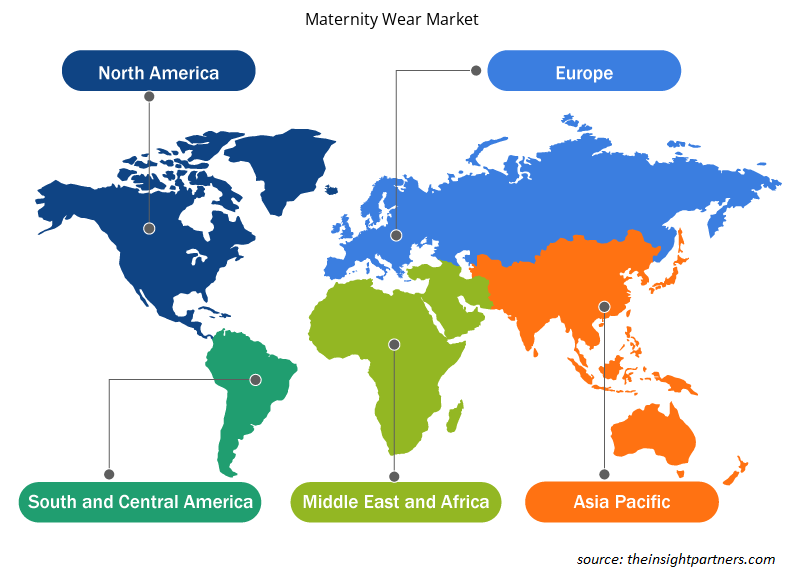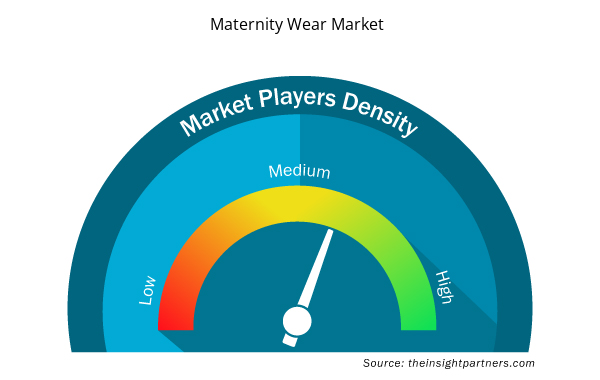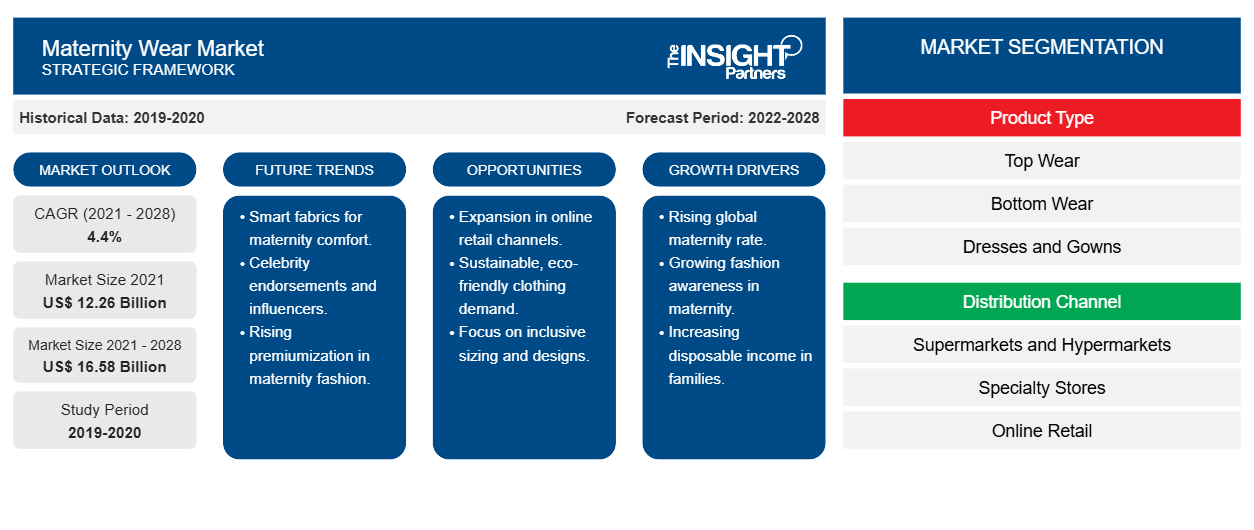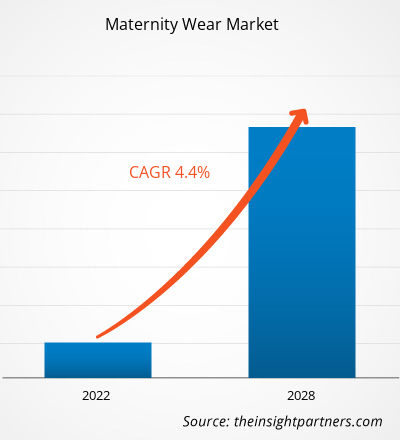بلغت قيمة سوق ملابس الأمومة 12،257.41 مليون دولار أمريكي في عام 2021 ومن المتوقع أن تصل إلى 16،578.64 مليون دولار أمريكي بحلول عام 2028؛ ومن المتوقع أن ينمو بمعدل نمو سنوي مركب قدره 4.4٪ من عام 2021 إلى عام 2028.
عادة ما يتم تصميم ملابس الأمومة بمقاس فضفاض ومناسب يحتوي على مطاط وعلامات تبويب وقماش قابل للتمدد، مثل الإيلاستين والإسباندكس، لتوفير راحة إضافية للمستهلك أثناء الحمل.
استحوذت منطقة آسيا والمحيط الهادئ على أكبر حصة من سوق ملابس الأمومة العالمية في عام 2020، في حين من المتوقع أن تسجل أمريكا الشمالية أعلى معدل نمو سنوي مركب خلال فترة التوقعات. وفقًا لتقرير البنك الدولي، يبلغ متوسط عدد النساء الحوامل العاملات في الولايات المتحدة 85%. وبالتالي، يتزايد الطلب على ملابس الأمومة والمقاسات الكبيرة في الملابس الرسمية ضمن قسم الفساتين الرسمية والفساتين. وهذا عامل رئيسي يساهم في نمو سوق ملابس الأمومة في أمريكا الشمالية.
تأثير جائحة كوفيد-19 على سوق ملابس الأمومة
لقد أثر جائحة كوفيد-19 سلبًا على العديد من الصناعات بما في ذلك صناعة السلع الاستهلاكية. لقد خلق الوباء صعوبات تشغيلية بسبب عمليات الإغلاق وإغلاق الأعمال وانقطاعات سلسلة التوريد. سجلت متاجر بيع الملابس والأزياء بالتجزئة خسائر كبيرة في المبيعات. كشفت النتائج المالية التي نشرتها العلامات التجارية للأزياء مثل مجموعة إنديتكس الإسبانية وH & M السويدية عن ضخامة تأثير الوباء. علاوة على ذلك، شهد التجارة الإلكترونية فائدة طويلة الأمد من الوباء، حيث يعتبر معظم المشترين عبر الإنترنت البيع بالتجزئة الإلكتروني خيارًا بعد الوباء. بالإضافة إلى ذلك، من المتوقع أن تؤثر معدلات التطعيم المتزايدة وإحياء أنشطة التصنيع وتخفيف القيود الحكومية بشكل إيجابي على سوق ملابس الأمومة العالمية خلال فترة التنبؤ.
قم بتخصيص هذا التقرير ليناسب متطلباتك
ستحصل على تخصيص لأي تقرير - مجانًا - بما في ذلك أجزاء من هذا التقرير، أو تحليل على مستوى الدولة، وحزمة بيانات Excel، بالإضافة إلى الاستفادة من العروض والخصومات الرائعة للشركات الناشئة والجامعات
- احصل على أهم اتجاهات السوق الرئيسية لهذا التقرير.ستتضمن هذه العينة المجانية تحليلاً للبيانات، بدءًا من اتجاهات السوق وحتى التقديرات والتوقعات.
رؤى السوق
إن تبني استراتيجيات نمو الأعمال يؤدي إلى نمو السوق
يتبنى اللاعبون الراسخون في السوق استراتيجيات مختلفة للتغلب على التحديات الحالية والمستقبلية لتوسع الشركة. على سبيل المثال، تبنت إيزابيلا أوليفر استراتيجية اختراق السوق من خلال إطلاق برنامج تأجير ملابس الأمومة لتحسين وصولها. في 20 يناير 2020، أطلقت العلامة التجارية مرة أخرى برنامج تأجير جديد لتصبح دائرية وزيادة طول عمر ملابس الأمومة. عرضت إيزابيلا أوليفر لعملائها مجموعة جديدة من الخيارات لاستئجار فستان، بما في ذلك ملابس الحفلات ومستلزمات الحمل الأساسية، لمدة أسبوعين، قبل إعادته مجانًا. حتى أن العلامة التجارية تعتني بالتنظيف الجاف. يمكن للعملاء أيضًا شراء المنتج. تتمثل فكرة تأجير ملابس الأمومة في تشجيع العملاء على التحول إلى اللون الأخضر والقضاء على آثار الموضة السريعة. لذا، أدت ابتكارات المنتجات واختراقاتها إلى زيادة الطلب على ملابس الأمومة. هذه العوامل تدفع نمو سوق ملابس الأمومة.
رؤى حول قنوات التوزيع
بناءً على قناة التوزيع، يتم تقسيم سوق ملابس الأمومة إلى محلات السوبر ماركت والهايبر ماركت والمتاجر المتخصصة وتجارة التجزئة عبر الإنترنت وغيرها. ومن المتوقع أن يسجل قطاع التجزئة عبر الإنترنت أعلى معدل نمو سنوي مركب خلال فترة التنبؤ. لعبت التجارة الإلكترونية دورًا حيويًا خلال الأشهر الأولى من جائحة كوفيد-19، حيث لم يُسمح لمتاجر التجزئة المادية بالعمل. أثناء عمليات الإغلاق، استخدم الناس بشكل متزايد منصات التجارة الإلكترونية لشراء المنتجات الأساسية وغير الأساسية. أدت الأزمة الاقتصادية الناجمة عن تفشي كوفيد-19 إلى انخفاض الدخل المتاح للنساء. ومع ذلك، لم يتأثر الطلب على ملابس الأمومة. ونتيجة لذلك، من المرجح أن يصبح التسعير التنافسي سمة رئيسية للمشهد الكامل في المستقبل. ومن المتوقع أن يعزز هذا العامل نمو السوق لشريحة التجزئة عبر الإنترنت خلال فترة التنبؤ.
رؤى حول نوع المنتج
بناءً على نوع المنتج، يتم تقسيم سوق ملابس الأمومة إلى ملابس علوية وملابس سفلية وفساتين وفساتين داخلية . استحوذت شريحة الملابس العلوية على حصة سوقية أكبر في عام 2020، ومن المتوقع أن تسجل شريحة الفساتين والفساتين معدل نمو سنوي مركب أعلى خلال فترة التوقعات. تتكون ملابس الأمومة العلوية من ملابس رسمية وملابس غير رسمية. علاوة على ذلك، يرتفع الطلب على ملابس الأمومة الرسمية بسبب العدد المتزايد من الإناث العاملات. تتكون ملابس الأمومة العلوية الرسمية من الكورتيس والبلوزات والفساتين ذات الدبابات المصنوعة من مواد ناعمة والسترات والمعاطف الخندقية ذات الطبقات المزدوجة. تتكون الملابس غير الرسمية من السترات والفساتين الطويلة والبلوزات والقمصان كبيرة الحجم. تُصنع ملابس الأمومة من أجود الأقمشة بمواد طبيعية ومريحة، مثل القطن والمودال والخيزران ، لأنها ناعمة وتسمح بالتنفس الثابت. تميل النساء الحوامل إلى اختيار المواد وفقًا للتغيرات الموسمية. في الصيف، يفضلون ارتداء الأقمشة الكتانية المقاومة للحرارة لتسهيل تدفق الهواء، بينما في الشتاء يفضلون ارتداء المعاطف الصوفية الدافئة للوقاية من البرد.
ومن بين اللاعبين القليلين الذين يعملون في سوق ملابس الأمومة شركة Gap Inc، وSeraphine، وIsabella Oliver، وH and M Hennes and Mauritz AB، وBrunelli and Co SRL، وMothercare، وBoob Design، وSHAICO Fashion Pvt. Ltd، وPink Blush Maternity، وOrganic & More.
رؤى إقليمية حول سوق ملابس الأمومة
لقد قام المحللون في Insight Partners بشرح الاتجاهات والعوامل الإقليمية المؤثرة على سوق ملابس الأمومة طوال فترة التوقعات بشكل شامل. يناقش هذا القسم أيضًا قطاعات سوق ملابس الأمومة والجغرافيا في جميع أنحاء أمريكا الشمالية وأوروبا ومنطقة آسيا والمحيط الهادئ والشرق الأوسط وأفريقيا وأمريكا الجنوبية والوسطى.

- احصل على البيانات الإقليمية المحددة لسوق ملابس الأمومة
نطاق تقرير سوق ملابس الأمومة
| سمة التقرير | تفاصيل |
|---|---|
| حجم السوق في عام 2021 | 12.26 مليار دولار أمريكي |
| حجم السوق بحلول عام 2028 | 16.58 مليار دولار أمريكي |
| معدل النمو السنوي المركب العالمي (2021 - 2028) | 4.4% |
| البيانات التاريخية | 2019-2020 |
| فترة التنبؤ | 2022-2028 |
| القطاعات المغطاة | حسب نوع المنتج
|
| المناطق والدول المغطاة | أمريكا الشمالية
|
| قادة السوق وملفات تعريف الشركات الرئيسية |
|
كثافة اللاعبين في السوق: فهم تأثيرها على ديناميكيات الأعمال
يشهد سوق ملابس الأمومة نموًا سريعًا، مدفوعًا بالطلب المتزايد من المستخدم النهائي بسبب عوامل مثل تفضيلات المستهلك المتطورة والتقدم التكنولوجي والوعي المتزايد بفوائد المنتج. ومع ارتفاع الطلب، تعمل الشركات على توسيع عروضها والابتكار لتلبية احتياجات المستهلكين والاستفادة من الاتجاهات الناشئة، مما يؤدي إلى زيادة نمو السوق.
تشير كثافة اللاعبين في السوق إلى توزيع الشركات أو المؤسسات العاملة في سوق أو صناعة معينة. وهي تشير إلى عدد المنافسين (اللاعبين في السوق) الموجودين في مساحة سوق معينة نسبة إلى حجمها أو قيمتها السوقية الإجمالية.
الشركات الرئيسية العاملة في سوق ملابس الأمومة هي:
- شركة جاب
- سيرافين
- ايزابيلا اوليفر
- اتش اند ام هينيس اند موريتس
- شركة برونيللي وشركاه المحدودة
إخلاء المسؤولية : الشركات المذكورة أعلاه ليست مرتبة بأي ترتيب معين.

- احصل على نظرة عامة على أهم اللاعبين الرئيسيين في سوق ملابس الأمومة
تقرير يسلط الضوء على
- اتجاهات الصناعة التقدمية في سوق ملابس الأمومة لمساعدة اللاعبين على تطوير استراتيجيات فعالة طويلة الأجل
- استراتيجيات نمو الأعمال التي تتبناها الأسواق المتقدمة والنامية
- التحليل الكمي لسوق ملابس الأمومة من 2019 إلى 2028
- تقدير الطلب العالمي على مكونات الألبان
- تحليل القوى الخمس لبورتر لتوضيح فعالية المشترين والموردين العاملين في الصناعة
- التطورات الأخيرة لفهم سيناريو السوق التنافسي
- اتجاهات السوق وتوقعاتها بالإضافة إلى العوامل التي تدفع وتكبح نمو سوق ملابس الأمومة
- المساعدة في عملية اتخاذ القرار من خلال تسليط الضوء على استراتيجيات السوق التي تدعم المصلحة التجارية، مما يؤدي إلى نمو السوق
- حجم سوق ملابس الأمومة في مختلف العقد
- نظرة عامة مفصلة وتقسيم السوق، بالإضافة إلى ديناميكيات صناعة ملابس الأمومة
- حجم سوق ملابس الأمومة في مختلف المناطق مع فرص نمو واعدة
- التحليل التاريخي (سنتان)، السنة الأساسية، التوقعات (7 سنوات) مع معدل النمو السنوي المركب
- تحليل PEST و SWOT
- حجم السوق والقيمة / الحجم - عالميًا وإقليميًا وقطريًا
- الصناعة والمنافسة
- مجموعة بيانات Excel


- Smart Parking Market
- Electronic Shelf Label Market
- Europe Industrial Chillers Market
- Drain Cleaning Equipment Market
- Human Microbiome Market
- Enteral Nutrition Market
- Trade Promotion Management Software Market
- Extracellular Matrix Market
- Artificial Intelligence in Healthcare Diagnosis Market
- Biopharmaceutical Tubing Market

Report Coverage
Revenue forecast, Company Analysis, Industry landscape, Growth factors, and Trends

Segment Covered
This text is related
to segments covered.

Regional Scope
North America, Europe, Asia Pacific, Middle East & Africa, South & Central America

Country Scope
This text is related
to country scope.
الأسئلة الشائعة
The global maternity wear market is driven by the rising number of pregnant working women coupled with the adoption of business growth strategies by the market players.
Based on distribution channel, the supermarkets and hypermarkets segment held the largest market share in 2020. Supermarkets and hypermarkets, considered as an effective distribution channel, are large retail stores that offer a wide range of maternity clothes. Many leading manufacturers of maternity clothes target selling their products through prominent supermarkets and hypermarkets chains, such as Mom & Baby, Mother Care, and FirstCry, as there is high customer traffic in these stores. This factor is also driving the popularity of supermarkets and hypermarkets for purchasing maternity clothes.
Top wear accounted for a major share in 2020. Maternity top-wear cloth consists of formal wear and casual wear. The demand for formal maternity top wear is rising due to the increasing number of working females. Formal maternity top-wear consists of kurtis, blouses, soft material tank dresses, blazers, and trench coats with double layers, and casual wear comprises tunics, maxi dresses, and oversize sweatshirts and t-shirts.
The major players operating in the global maternity wear market are Gap Inc, Seraphine, Isabella Oliver, H & M Hennes and Maurits, Brunelli & Co. S.R.L., Mothercare, Boob Design, Pinkblush Maternity, Adidas America Inc., and Organic and More among others.
In 2020, Asia Pacific held the largest share in the global maternity wear market. Asia-Pacific continent comprises several developing and developed economies such as India, China, Japan, South Korea, and Australia. These emerging countries are witnessing an increase in spending by new mothers to be over their first pregnancy photo-shoots, accompanied by growing purchasing capacity of women in this region.
Trends and growth analysis reports related to Consumer Goods : READ MORE..
The List of Companies - Maternity Wear Market
- Gap Inc
- Seraphine
- Isabella Oliver
- H & M Hennes and Maurits
- Brunelli & Co. S.R.L
- Mothercare
- Boob Design
- Shaico Design Pvt. Ltd.
- Pinkblush Maternity
- Organic & More
The Insight Partners performs research in 4 major stages: Data Collection & Secondary Research, Primary Research, Data Analysis and Data Triangulation & Final Review.
- Data Collection and Secondary Research:
As a market research and consulting firm operating from a decade, we have published and advised several client across the globe. First step for any study will start with an assessment of currently available data and insights from existing reports. Further, historical and current market information is collected from Investor Presentations, Annual Reports, SEC Filings, etc., and other information related to company’s performance and market positioning are gathered from Paid Databases (Factiva, Hoovers, and Reuters) and various other publications available in public domain.
Several associations trade associates, technical forums, institutes, societies and organization are accessed to gain technical as well as market related insights through their publications such as research papers, blogs and press releases related to the studies are referred to get cues about the market. Further, white papers, journals, magazines, and other news articles published in last 3 years are scrutinized and analyzed to understand the current market trends.
- Primary Research:
The primarily interview analysis comprise of data obtained from industry participants interview and answers to survey questions gathered by in-house primary team.
For primary research, interviews are conducted with industry experts/CEOs/Marketing Managers/VPs/Subject Matter Experts from both demand and supply side to get a 360-degree view of the market. The primary team conducts several interviews based on the complexity of the markets to understand the various market trends and dynamics which makes research more credible and precise.
A typical research interview fulfils the following functions:
- Provides first-hand information on the market size, market trends, growth trends, competitive landscape, and outlook
- Validates and strengthens in-house secondary research findings
- Develops the analysis team’s expertise and market understanding
Primary research involves email interactions and telephone interviews for each market, category, segment, and sub-segment across geographies. The participants who typically take part in such a process include, but are not limited to:
- Industry participants: VPs, business development managers, market intelligence managers and national sales managers
- Outside experts: Valuation experts, research analysts and key opinion leaders specializing in the electronics and semiconductor industry.
Below is the breakup of our primary respondents by company, designation, and region:

Once we receive the confirmation from primary research sources or primary respondents, we finalize the base year market estimation and forecast the data as per the macroeconomic and microeconomic factors assessed during data collection.
- Data Analysis:
Once data is validated through both secondary as well as primary respondents, we finalize the market estimations by hypothesis formulation and factor analysis at regional and country level.
- Macro-Economic Factor Analysis:
We analyse macroeconomic indicators such the gross domestic product (GDP), increase in the demand for goods and services across industries, technological advancement, regional economic growth, governmental policies, the influence of COVID-19, PEST analysis, and other aspects. This analysis aids in setting benchmarks for various nations/regions and approximating market splits. Additionally, the general trend of the aforementioned components aid in determining the market's development possibilities.
- Country Level Data:
Various factors that are especially aligned to the country are taken into account to determine the market size for a certain area and country, including the presence of vendors, such as headquarters and offices, the country's GDP, demand patterns, and industry growth. To comprehend the market dynamics for the nation, a number of growth variables, inhibitors, application areas, and current market trends are researched. The aforementioned elements aid in determining the country's overall market's growth potential.
- Company Profile:
The “Table of Contents” is formulated by listing and analyzing more than 25 - 30 companies operating in the market ecosystem across geographies. However, we profile only 10 companies as a standard practice in our syndicate reports. These 10 companies comprise leading, emerging, and regional players. Nonetheless, our analysis is not restricted to the 10 listed companies, we also analyze other companies present in the market to develop a holistic view and understand the prevailing trends. The “Company Profiles” section in the report covers key facts, business description, products & services, financial information, SWOT analysis, and key developments. The financial information presented is extracted from the annual reports and official documents of the publicly listed companies. Upon collecting the information for the sections of respective companies, we verify them via various primary sources and then compile the data in respective company profiles. The company level information helps us in deriving the base number as well as in forecasting the market size.
- Developing Base Number:
Aggregation of sales statistics (2020-2022) and macro-economic factor, and other secondary and primary research insights are utilized to arrive at base number and related market shares for 2022. The data gaps are identified in this step and relevant market data is analyzed, collected from paid primary interviews or databases. On finalizing the base year market size, forecasts are developed on the basis of macro-economic, industry and market growth factors and company level analysis.
- Data Triangulation and Final Review:
The market findings and base year market size calculations are validated from supply as well as demand side. Demand side validations are based on macro-economic factor analysis and benchmarks for respective regions and countries. In case of supply side validations, revenues of major companies are estimated (in case not available) based on industry benchmark, approximate number of employees, product portfolio, and primary interviews revenues are gathered. Further revenue from target product/service segment is assessed to avoid overshooting of market statistics. In case of heavy deviations between supply and demand side values, all thes steps are repeated to achieve synchronization.
We follow an iterative model, wherein we share our research findings with Subject Matter Experts (SME’s) and Key Opinion Leaders (KOLs) until consensus view of the market is not formulated – this model negates any drastic deviation in the opinions of experts. Only validated and universally acceptable research findings are quoted in our reports.
We have important check points that we use to validate our research findings – which we call – data triangulation, where we validate the information, we generate from secondary sources with primary interviews and then we re-validate with our internal data bases and Subject matter experts. This comprehensive model enables us to deliver high quality, reliable data in shortest possible time.


 احصل على عينة مجانية لهذا التقرير
احصل على عينة مجانية لهذا التقرير